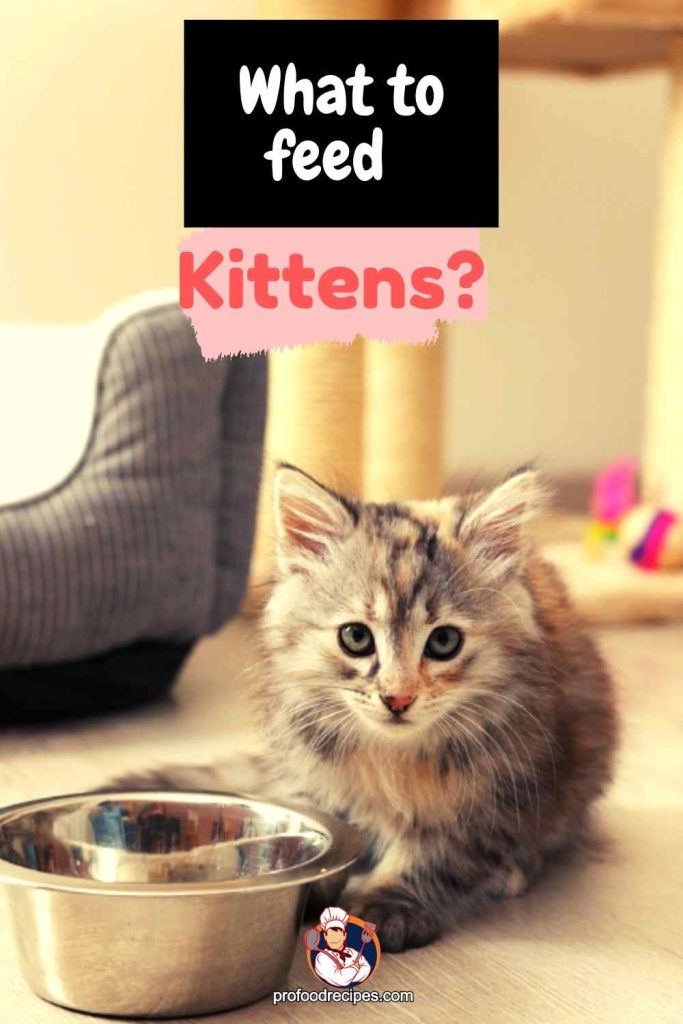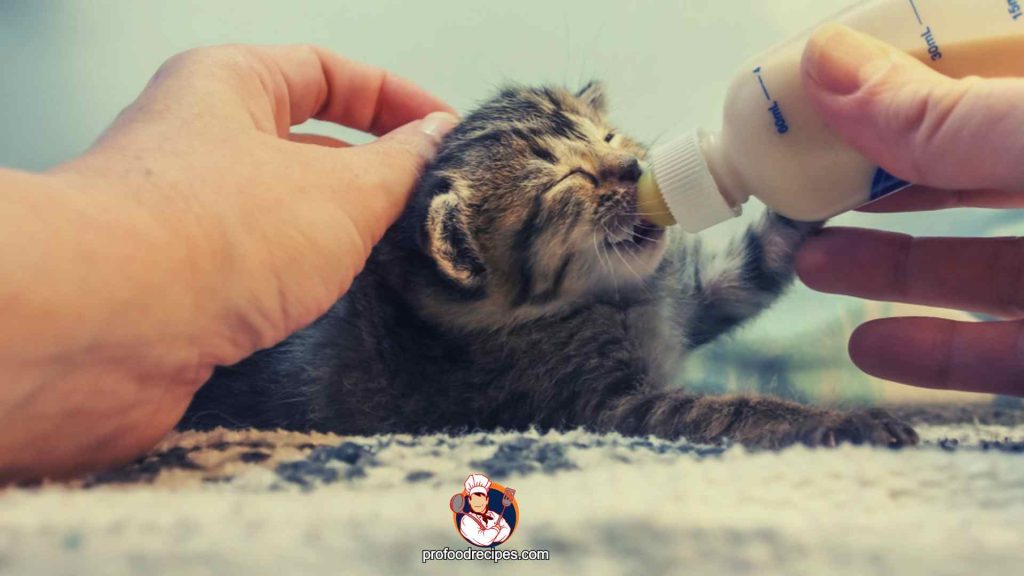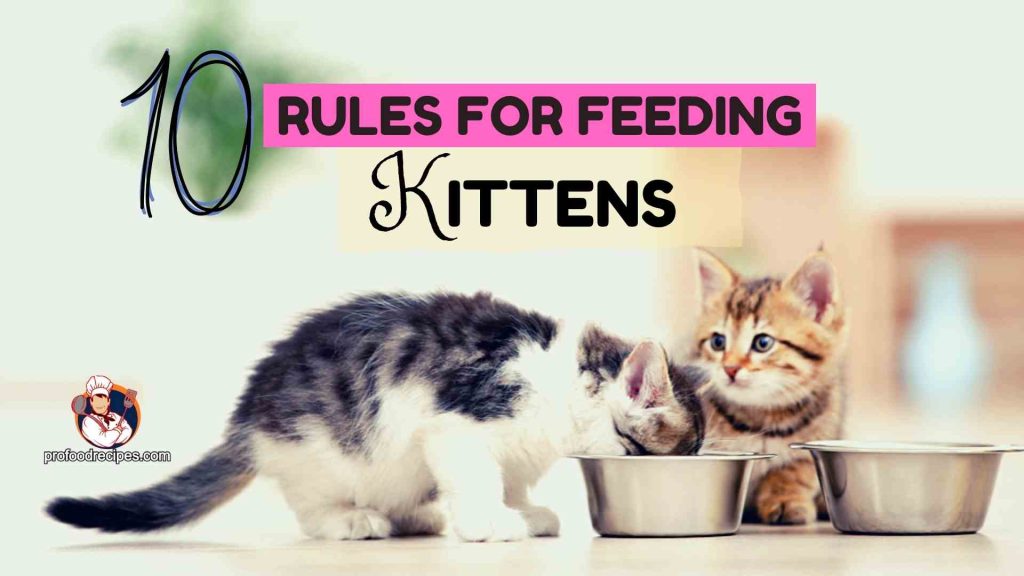Last Updated on November 15, 2022 by Amanda P. Brown
How should a kitten’s diet be planned after recently weaning from its mother? When should I switch to adult food? And what happens if you feed your baby cow’s milk and fresh meat? The following article describes what to feed kittens from 0 to 12 months and how to introduce the first complementary food without harm to the digestive system.
Where to Start?
Table of Contents
To build a balanced diet and determine the feeding schedule, you need initial data: the exact age of the kitten and information about what you fed it before.
If a pet is brought to the house directly from the breeder, all information, including the weight gain schedule, can be obtained from him. The most optimal age of weaning from the mother is 2-3 months.
By this time, the animal already eats solid food and has primary immunity, obtained through the mucous membrane of the stomach and intestines with the mother’s milk.
For the first 7-10 days in the new home, the kitten is fed the same food as in the nursery, ensuring that the animal does not overeat. It is due to the already-developed set of enzymes necessary for food consumption. If you introduce a new feed in one day, the body will not have time to adjust and will react with vomiting and stool disorders, up to an emergency call to the veterinarian.
Therefore, you need to introduce new foods gradually, offering them first for testing and mixing them with the old feed in a ratio of 1:5, where a smaller part is allocated to the new one and a large part to the old one. Then 2: 4, 3: 3 – and so on until the new feed completely replaces the old one.
The average transition time from the old feed to the new one is 7 to 14 days. If the pet is picked up on the street and the exact age is unknown, the animal must show to the veterinarian.
But suppose the kitten’s condition is critical, and there is no time left for a trip to the clinic. In that case, it is permissible to feed the baby with a decoction of rice, a substitute for cat’s milk from a pet store, or, in extreme cases, dry baby formula. These food are safe for kittens even in the first week of life and will not cause indigestion.

When to Introduce the First Complementary Food?
According to veterinary practice, the cat feeds kittens for 40-60 days. This period is needed to establish immunity, reducing the body’s susceptibility to infectious and viral diseases that the animal will encounter in the future. So, when should complementary foods be introduced?
You don’t need to introduce supplemental foods to newborns within the first month of life. All the nutrients come from the mother’s milk, enough for the cubs.
However, if this is multiple litters, where stronger and stronger individuals push back the weak ones, and there is not enough milk for everyone, or the kittens are weaned too early, the babies will have to be fed from the first days of life. The main thing is to monitor the dynamics of weight gain and avoid overfeeding.
What to Feed Kittens?

The information included below is intended to serve as a full feeding guide for kittens, organized according to age.
Feeding a Kitten From 0 to 4 Weeks
There are two ways to make up for the lack of mother’s milk: – find a wet nurse cat or transfer the animal to artificial mixtures. You can find a newly born cat through a veterinarian or special forums on the Internet.
However, not every animal will accept someone else’s cub and will not harm it, especially if it smells someone else’s smell from it. Therefore, switching to artificial feeding will be more straightforward.
You can feed your baby with a cat’s milk substitute – it is available in powder or liquid form. The main thing is not to confuse it with lactose-free milk for adult cats. It’s not the same thing.
Starting from the 8th day of life, the animal can absorb liquid vitamins, which are injected into the mouth with a syringe without a needle. A veterinarian will help you choose a vitamin complex.
During the introduction of a new feed, the kitten begins to have indigestion, the mixture is diluted with water, or a few spoons of chamomile decoction are added. If the condition does not stabilize, use drugs with bifidobacteria.
Feeding a Kitten From 1 to 2 Months
From the age of 3-4 weeks, the kitten is ready for the first bait with semi-solid food. You can feed both industrial and natural food. The choice depends on the owner’s wishes. But whatever they are, the main thing is to keep the feed distinct from one another. This will lead to an imbalance of nutrients and disruption of the digestive system.
If given to a straight woman, all ingredients should be fresh and preferably from the same manufacturer. The daily serving size should not exceed 120-130 g, of which 60% is reserved for protein, 10% for fat, and 30% for carbohydrates.
The list of permitted foods includes low-fat cottage cheese, porridge with milk broth, thin soups, and egg yolk. The piece should be lean and brought to a puree-like state when adding meat. Adding spices and sugar is strictly prohibited.
If you feed industrial food, pates for kittens, diluted with water or a milk mixture, are suitable. The manufacturer already calculates the daily energy requirement. The kitten eats 1-2 sachets a day.
The list of permitted feeds includes a premium or super-premium wet food. High-quality food is delivered without salt, colorants, flavor enhancers, and aromatic additives.
To thoroughly transfer a kitten from milk formula to semi-solid food, you need to gradually increase the share of new foods, alternating milk and complementary foods or mixing them.
Feeding a Kitten From 2 to 4 Months
From 2-4 months, the kitten is ready to eat solid food. The pieces should be small but dense enough for the animal to learn to chew and strengthen the jaw muscles.
If you give a straight person, he will supplement the list of allowed foods with boiled vegetables, low-fat sea fish (hake, haddock, cod), sprouted wheat and oat sprouts, cereals, and fermented dairy foods (kefir, yogurt, low-fat cottage cheese). The serving size increases to 160-180 g.
If you feed industrial food, dry premium food, and super-premium class kittens with a minimum granule size is suitable. High-quality food should be high-energy, with high protein and calcium content. Each day, the kitten eats 40-50 g of dry food, 2-2. 5 bags of wet food, or 15-30 g of dry food mixed with -1 bag of wet food.
To interest the kitten in solid food, it is soaked in water. This is necessary to give the food a familiar consistency and enhance the smell.
Feeding a Kitten From 4 to 6 Months
The diet remains the same if the animal switches to solid food without complications. Only the portion size increases.
If you feed a straight woman, the portion size is determined by the current energy requirement (see Table 3). The average daily serving size is 180-240 g.
If industrial feed – by the manufacturer’s instructions. Usually, the kitten eats 50-65 g of dry food, 2.5-3 bags of wet or 30-45 g of dry mixed with- 1 bag of wet.
Feeding a Kitten From 6 to 12 Months
The pet can switch to adult feeds and portion sizes by the year’s first half.
Cats are transferred to the adult line as early as – 6 months. They grow and develop faster. Kotov – a little later. They reach adult size more slowly.
Read More: Best Homemade Food for Persian Kitten
The Normal Weight of a Kitten
You can track the average weight gain in the first year of life in Table 2. If the animal gains weight more slowly or, conversely, overeats, you need to consult a veterinarian. The food is probably too heavy or doesn’t contain enough nutrients for active growth.
| Age | Average weight of a kitten |
| 1 week | 113 g |
| 2 weeks | 200 g |
| 3 weeks | 280 g |
| 4 weeks | 370 g |
| 2 months | 700-1500 g |
| 3 months | 1480-1790 |
| 4 months | 1880-2400 g |
| 5 months | 2290-2900 g |
| 6 months | 2550-3390 g |
| 7 months | 2620-3750 g |
| 8 months | 2700-4000 g |
| 9 months | 2800-4100 g |
| 10 months | 2810-4200 g |
| 11 months | 3000-4350 g |
| 12 months | 3150-4400 g |
The Daily Energy Requirement of a Kitten
The daily need for energy and calories, taking into account the pet’s age, can be tracked in Table 3. If the baby is transferred to a straight woman, the daily rate of KBZHU is calculated using formulas and calorie calculators. If for industrial, feed-compare the values from the table with the information on the back of the package.
When feeding ready-made food, all calculations are made by the manufacturer. It remains for the owner to measure out the portion by the current weight of the animal and introduce a new feed with the transition to a new age group.
| Age | J | Kcal |
| Up to 8 weeks | 628 | 151 |
| Up to 3 months | 837 | 200 |
| Up to 6 months | 963 | 230 |
| Cat weighing -3 kg | 1005 | 240 |
| Cat weighing -4 kg | 1340 | 320 |
| Cat weighing- 5 kg | 1465 | 350 |
How to Make a Feeding Timetable?
General recommendations for serving size can be found on the back of the feed package. But for most kittens, the feeding scheme is as follows:
| Age | Mixture temperature | Feeding mode |
| 1-7 days | 38 degrees | 10-12 times a day (every 2 hours) |
| 7-14 days | 38 degrees | 10 times a day (every 2.5 hours) |
| 14-21 days | 30-32 degrees | 8-10 times a day (every 2.5-3 hours) |
| 21-30 days | 28-30 degrees | 8 times a day (every 3 hours) |
| 30 days | 24-26 degrees | 6-8 times a day (every 4 hours) |
| 1-3 months | 15-25 degrees | 6 times a day (every 4-5 hours) |
| 4-5 months | 15-25 degrees | 4-5 times a day (every 5 hours) |
| 6-9 months | 15-25 degrees | 3-4 times a day (every 6 hours) |
| 9-12 months | 15-25 degrees | 1-2 times a day (every 8 hours) |
Can I Give My Kitten Milk?
Feeding undiluted kitten milk is dangerous for its digestion. Whole cow’s milk causes upset stools and severe dehydration in kittens. This is due to immunity to milk sugar (lactose). Also, it forms a sticky mass (casein) in the stomach and is not digested, causing bloating and colic.
But even with the relative adoption of an atypical diet, there will be fewer nutrients, and the animal will develop more slowly. Below is a table with a detailed analysis of cow’s and cat’s milk in terms of protein, fat, and carbohydrate balance:
| Composition | Cat’s milk | Cow’s milk |
| Water | 82,4 | 87,4 |
| Lactose | 4,8 | 4,8 |
| Squirrels | 7,0 | 3,3 |
| Fats | 4,8 | 3,8 |
How to Feed a Newborn Kitten?

Its weight should be twice for the first – 8 days of a kitten’s life. A healthy individual sucks milk up to 10-12 times, taking up to 3 hours to absorb food. The animal spends its remaining time sleeping and growing actively.
If the kitten is complete, it sleeps peacefully and behaves quietly. If hungry, it lets out a squeak, crawls restlessly around the nest, and sucks the outstretched finger.
To feed a newborn kitten, follow the instructions below:
1. Prepare Your Inventory
A newborn kitten can eat from a syringe without a needle or an eye drop pack. But it is preferable to buy a special bottle with an anatomical pacifier. It will help develop the sucking reflex and strengthen the jaw muscles. In addition, the baby will eat as much as possible and will not choke.
Make sure that the opening in the nipple is narrow. Otherwise, the baby may choke and inhale the liquid into the lungs.
2. Prepare the Mixture
Food for a newborn kitten should be warm (38 degrees) and sterile. The bottle and pacifier should be sterilized in a steam sterilizer – just like bottles for newborns – or treated with a cold sterilization liquid. Preheat the food in a water bath – if you use a microwave oven, the liquid will warm up unevenly, and the kitten may get burned.
Follow the instructions on the mix pack to determine what portion size you want. Concentrated food will lead to indigestion. Watery – leads to a lack of nutrients.
To check the temperature of the feed, apply it to your wrist. The liquid should be warm and close to body temperature.
If the kitten has diarrhea, dilute the food with water. The standard concentration calculated by the manufacturer is probably not suitable for him yet.
3. Take a Comfortable Position
Place the kitten on your lap, belly down, and lock its muzzle between your index finger and middle finger, avoiding tipping its head up or back. This situation leads to the throwing the mixture into the lungs, followed by the development of pneumonia.
4. Feed Your Kitten
Squeeze a drop of the mixture on the tip of the nipple and bring it to your mouth. The kitten will immediately reach out to you when smelling the smell of milk. But if this does not happen, put the pacifier in the mouth yourself and make sure that the baby actively sucks, swallows, and regurgitates to release excess air.
Inject the food slowly if you feed your kitten with a syringe or an eye drop bottle. Ensure the milk doesn’t come out of the nose and the kitten doesn’t feel gagged.
5. Encourage Urination and defecation
Pat the kitten on the stomach and wipe the anal opening and genitals with a wet baby cloth, imitating the licking of a mother cat. This is necessary to stimulate the removal of urine and feces.
When the kitten has urinated and made a toilet, wipe the excrement and functional holes with a clean cloth and leave the baby until the next feeding.
What Should Avoid Given to a Kitten?
If you plan to give your kitten natural food, make sure that the following ingredients are not included in your pet’s diet:
- Fatty Meat: Fatty meats are poorly digested, leading to indigestion and metabolic disorders.
- Sausage: A slice of sausage has a lot of fat, salt, and spices. This food leads to digestive disorders and disruption of the pancreas.
- Dice: Lead to mechanical injuries of the larynx and esophagus and can cause gastric or intestinal obstruction.
- Canned Fish: If there are preservatives in the composition, they are not helpful for the kitten.
- From the Table Food: Kittens do not digest salty, fried, smoked, or spicy food very well. Long-term complementary feeding with the remains of human food reduces life expectancy and several chronic diseases that occur in old age.
- Sweets (Chocolate, Candy, Ice cream): Sudden insulin jumps lead to diabetes mellitus. Even an adult cat is poisonous to sugar alcohol theobromine and xylitol contained in chocolates and candy cause seizures.
- Yeast Dough: If you feed a kitten bread, the animal will face bloating and colic.
- Legumes: This causes flatulence and heaviness in the stomach.
- Grapes and Raisins: The berries’ chemical composition provokes kidney failure development.
- Freshwater Fish: A source of parasites and small bones that can cause mechanical injury.
- Potato: A ballast food with a high content of indigestible starch.
Read More: How to Choose Cat Food or Cook It Yourself?
10 Rules for Feeding Kittens

- Equip the Nest: Put a hot water bottle under the bedding and keep it clean. Newborn kittens cannot independently maintain an optimal body temperature and are highly susceptible to viruses and infections.
- Keep Track of Your Weight Gain: For the first – 2 weeks, the kitten should add 14 g daily.
- Don’t Cook for Future Reference: Ready-made food for kittens is stored in the refrigerator for no more than 24 hours.
- Daily Serving: Stick to your daily serving size. If the kitten feels incomplete, do not overfeed. The leading indicator of satiety is a dense but not swollen stomach. If the kitten doesn’t finish eating, don’t be nervous. The peculiarities of the body and hunger are to blame for this. Some consume less food.
- Preheat the Food: Preheat the food to room temperature or higher (depending on the pet’s age). You should keep food from the refrigerator from being given. Indigestion and vomiting may result from this.
- Mixing Food: Do not mix industrial and natural food and feed from different manufacturers in the same bowl. This leads to an imbalance of nutrients and a serious failure of metabolic processes. Only a veterinary dietitian can prescribe a mixed diet. And only if there are special indications.
- Introduce New Ingredients Gradually: Introduce new foods in small portions. To digest unfamiliar food, the body needs to develop certain enzymes.
- Cow’s Milk: Don’t drink whole cow’s milk. Kittens do not tolerate highly concentrated lactose.
- Raw Meat: Do not feed raw meat. Raw meat is a source of helminthic eggs and viruses.
- Vitamin and Mineral: Do not give vitamin and mineral complexes without indications. If the kitten eats industrial food, the norm of vitamins and minerals is considered in the feed composition. If using natural products, consult your veterinarian. The dosage and type of complex are determined individually.
Final Verdict
Your kitten is like your most close partner at your home. What to feed kittens? – is the most commonly asked question for you as an owner of your kitten. This article can aid you in deciding what food you can take according to its requirement. You can make a diet plan considering its age and body requirements. Then feed your kitten with all nutrient food and a balanced diet.
You May Also Like to Read:
